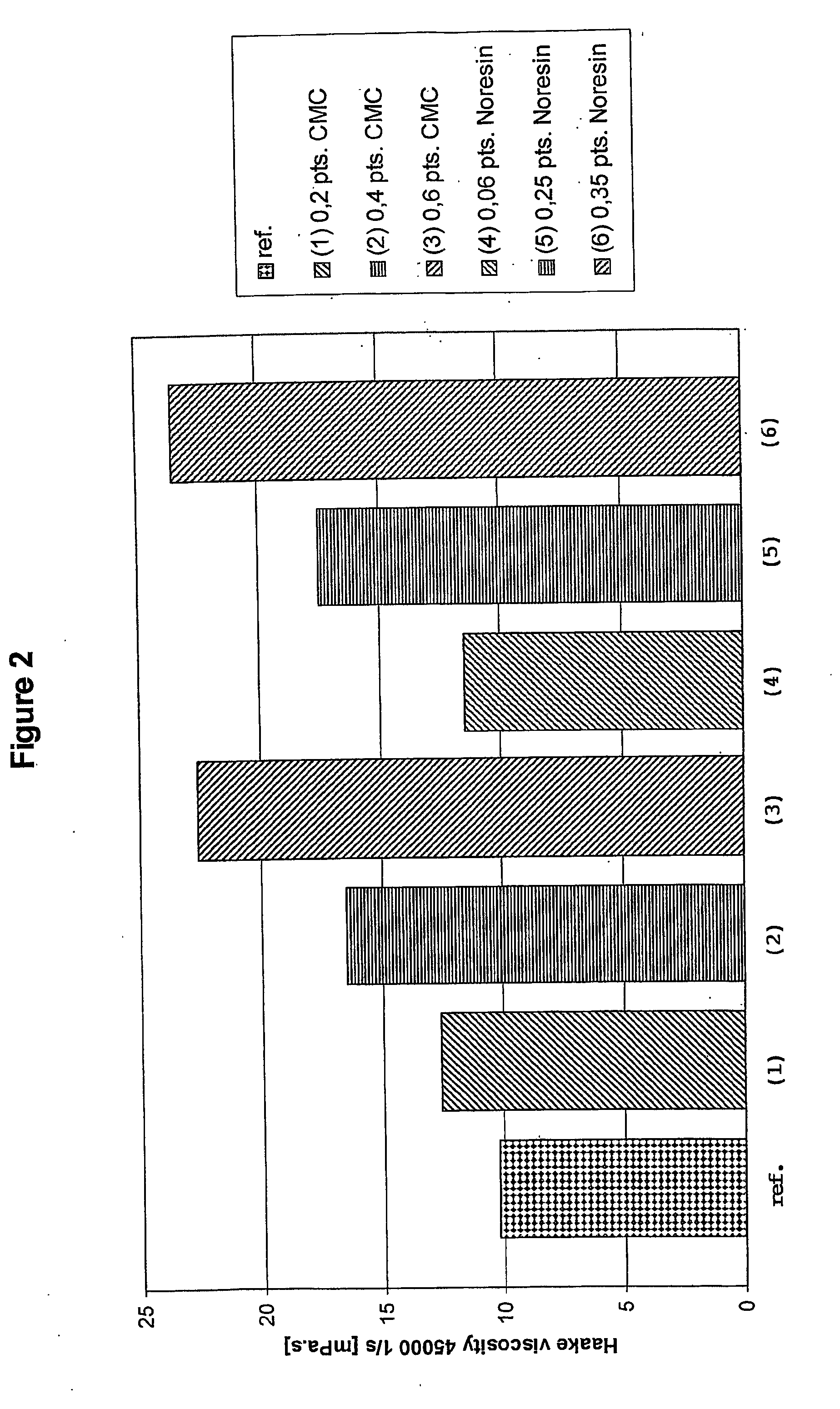Thickener for paper coating compositions
a technology of cellulose ether and composition, which is applied in the field of paper coating composition, can solve the problems of prohibitively high price tag, poor stability of cellulose ether-based compositions, and no product has proved to be entirely satisfactory
- Summary
- Abstract
- Description
- Claims
- Application Information
AI Technical Summary
Problems solved by technology
Method used
Image
Examples
example 1
Comparison of the Properties of CMC and a Cold Water Swellable (cws) Starch Ester According to the Invention
[0046] A series of tests with 0.2, 0.4 and 0.6 parts CMC FF5 (from Noviant) were performed—parts expressed per 100 parts pigment. The amount of Noresin™ A 180 (a cold water swellable starch carbamate phosphate ester available from Blattmann Cerestar AG) required, in each case, to reach the same Brookfield viscosity was then determined.
CMC and Noresin™ Preparation:
[0047] CMC and Noresin™ were added to tap water at about 40° C. and homogenised with a Type LD50 dissolver (Pendraulik GmbH) for 30 minutes. The CMC was prepared at 15.1% dry solids and the Noresin™ at 9.4% and 5.5% dry solids, respectively. Brookfield viscosity was then determined at 50° C. and 100 rpm (with a Brookfield RVF viscometer). Results are shown in Table 1 and FIG. 4.
TABLE 1Viscosity data for:CMCNoresin ™Dry solids (%)15.19.45.5pH5.47.27.2Brookfield viscosity 100 rpm at 50° C.405098503120(mPa · s)
[004...
example 2
Influence of Dry Solids on Brookfield Viscosity
[0057] A number of thickener solutions were prepared as detailed in Table 3. Trials 1 and 1a used Noresin™ A 180. Trials 2 and 2a used cold water swellable native maize starch (Cerestar). Trials 3 and 3a used oxidised cold water swellable starch (Cerestar). Trials 4, 4a, 4.1 and 4.1a used CMC FF150 (Noviant). Trials 5 and 5a used a cold water swellable starch ether (Cerestar) and, finally, trial 6 used a cold water swellable hydroxypropylated, non-ionic potato starch ether (Emsland Stärke GmbH).
[0058] The thickener was added to tap water at 40° C. in a 2 litre metal beaker and stirred at approximately 3200 rpm for 20 minutes. The amount of thickener added was calculated based on the desired dry solid content (see Table 3). pH was adjusted to the values shown in Table 3 using 50% NaOH solution (for each thickener, a near-neutral and an alkaline pH were tested to emulate the differences in viscosity and stability when these compounds ar...
example 3
Influence of Stirring Time on Brookfield Viscosity
[0062] Noresin™ and cws native maize starch solutions were prepared by adding 2.3% dry substance and 8.9% dry substance, respectively, to tap water at 40° C. in a 1 litre metal beaker. The solutions were then mixed at 3200 rpm for 20 minutes. Brookfield viscosity was measured using standard methods (as above). The results are set out in Table 4 and in FIG. 11.
TABLE 4C*Plus 12015Noresin ™ (2.3% ds)(8.9% ds)Time (min)Brookfield viscosity 100 rpm / 30° C. (mPa · s)51100750101040680151030720301010880609501040120940117018093011302409401210
[0063] As can bee seen from these results, the Brookfield viscosity of Noresin™ solutions is surprisingly stable compared to that of conventional thickeners.
PUM
| Property | Measurement | Unit |
|---|---|---|
| temperature | aaaaa | aaaaa |
| temperature | aaaaa | aaaaa |
| temperature | aaaaa | aaaaa |
Abstract
Description
Claims
Application Information
 Login to View More
Login to View More - R&D
- Intellectual Property
- Life Sciences
- Materials
- Tech Scout
- Unparalleled Data Quality
- Higher Quality Content
- 60% Fewer Hallucinations
Browse by: Latest US Patents, China's latest patents, Technical Efficacy Thesaurus, Application Domain, Technology Topic, Popular Technical Reports.
© 2025 PatSnap. All rights reserved.Legal|Privacy policy|Modern Slavery Act Transparency Statement|Sitemap|About US| Contact US: help@patsnap.com



